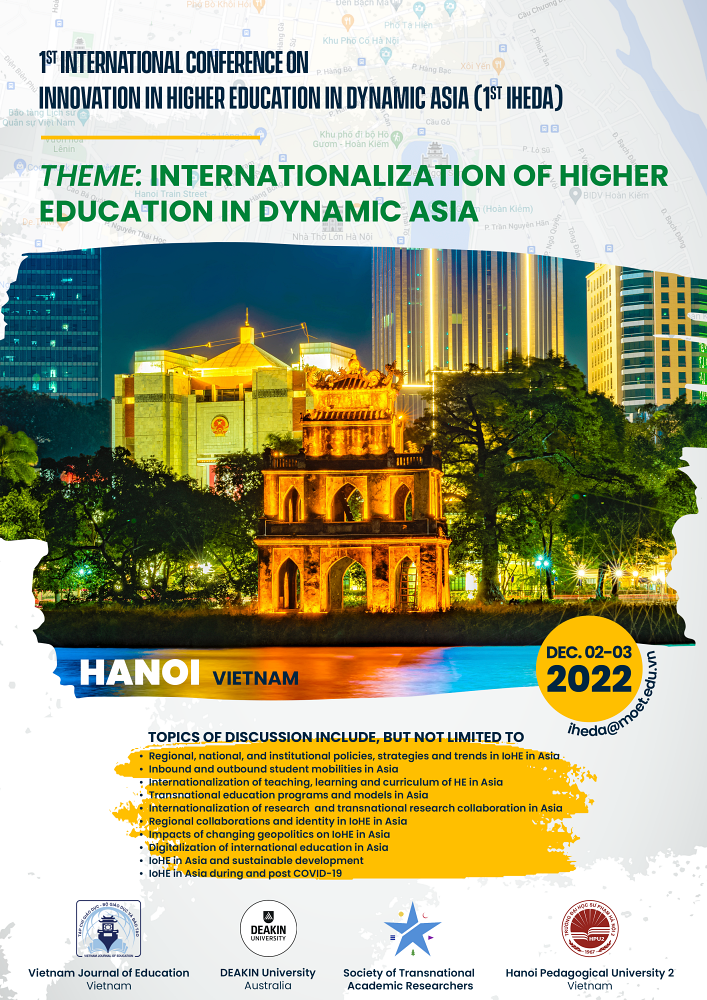High School Students’ Statistical Literacy Changes in a Flipped Classroom Environment: A Quasi-Experimental Study
DOI:
https://doi.org/10.52296/vje.2024.365-
Downloads
How to Cite
Abstract
Statistics in the 2018 Vietnam General Education Curriculum for Mathematics is emphasized from Grade 2 to Grade 12, helping develop students’ competences and qualities. However, students still struggle to connect and apply statistical concepts to real-life situations. This study used a flipped classroom model to teach 10th-graders statistics to develop their statistical literacy. Using a quasi-experimental design, we evaluated how the students’ statistical literacy developed as they participated in the flipped classroom. The results show that the flipped classroom improves students’ statistical literacy. All four categories of statistical literacy increased statistically significantly, including graphical displays, measures of central tendency, measures of variability, and using statistical knowledge to solve problems. The results are explained by the opportunities embedded into the program. Time outside of class was used for the students to review content and access new concepts, along with questions to demonstrate their statistical knowledge and reveal shortcomings. The students spent the most of their interaction time in class on activities to understand concepts and applied them to real-life situations. Some lessons learned from the study are discussed.
Downloads
References
Brooks, N., & Weaver, H. (2017). Two sides of the flip in middle grades ELA: Student and teacher perspectives. In Applying the Flipped Classroom Model to English Language Arts Education (pp. 79-90). IGI Global.
Callingham, R., & Watson, J. M. (2017). The development of statistical literacy at school. Statistics Education Research Journal, 16(1), 181-201.
Çevikbaş, M., & Kaiser, G. (2022). Can flipped classroom pedagogy offer promising perspectives for mathematics education on pandemic-related issues? A systematic literature review. ZDM - Mathematics Education, 55(1), 177-191. https://doi.org/10.1007/s11858-022-01388-w
Clark, D. M., Ehlers, A., McManus, F., Hackmann, A., Fennell, M., Campbell, H., Flower, T., Davenport, C., & Louis, B. (2003). Cognitive therapy versus fluoxetine in generalized social phobia: a Randomized Placebo-Controlled Trial. Journal of Consulting and Clinical Psychology, 71(6), 1058-1067.
Dove, A. (2013). Students’ Perceptions of Learning in a Flipped Statistics Class. In R. McBride & M. Searson (Eds.), Proceedings of SITE 2013--Society for Information Technology & Teacher Education International Conference (pp. 393-398). New Orleans, Louisiana, United States: Association for the Advancement of Computing in Education (AACE). https://www.learntechlib.org/primary/p/48133
Farmus, L., Cribbie, R. A., & Rotondi, M. (2020). The Flipped Classroom in Introductory Statistics: Early Evidence from a Systematic Review and Meta-Analysis. Journal of Statistics Education, 28(3), 316-325. https://doi.org/10.1080/10691898.2020.1834475
Frost, J. (2013). Why statistics is important. The World of Statistics. http://www.worldofstatistics.org/2013/03/04/why-statistics-is-important/
Gal, L. (2002). Adults’ statistical literacy: Meanings, components, responsibilities. International Statistical Review, 70(1), 1-15. https://doi.org/10.2307/1403713
Garfield, J., delMas, R., & Zieffler, A. (2010). Assessing statistical thinking. In P. Bidgood, N. Hunt, & F. Jolliffe (Eds.), Assessment methods in statistical education: An international perspective (pp. 175-186). John Wiley & Sons.
Karaca, C., & Ocak, M. A. (2017). Effect of Flipped Learning on Cognitive Load: A Higher Education Research. Journal of Learning and Teaching in Digital Age, 2(1), 20-27.
Leavy, A., & Hourigan, M. (2016). Crime scenes and mystery players! Using driving questions to support the development of statistical literacy. Teaching Statistics, 38, 29-35. https://doi.org/10.1111/test.12088
Lo, C. K., & Hew, K. F. (2017). A critical review of flipped classroom challenges in K-12 education: Possible solutions and recommendations for future research. Research and Practice in Technology Enhanced Learning, 12(4), 1-22. https://doi.org/10.1186/s41039-016-0044-2
MOET (2018). General Education Program Master program (Promulgated together with Circular No. 32/2018/TT-BGDĐT dated December 26, 2018, of the Minister of Education and Training).
Nguyen, A. T. T., & Tran, D. (2024). Quantitative reasoning as a lens to examine changes in modelling competencies of secondary preservice teachers. Mathematics Education Research Journal.
Tran, D., & O’Connor, B. R. (2023). Teacher curriculum competence: how teachers act in curriculum making. Journal of Curriculum Studies, 56(1), 1-16. https://doi.org/10.1080/00220272.2023.2271541
Tran, D., Nguyen, T. T. A., Nguyen, T. D., & Ta, T. M. P. (2022). Developing Teaching Statistical Thinking Competence for High School Teachers Using Technology with Real Data. National Foundation for Science & Technology Development, Vietnam.
Voigt, M., Fredriksen, H., & Rasmussen, C. (2020). Leveraging the design heuristics of realistic mathematics education and culturally responsive pedagogy to create a richer flipped classroom calculus curriculum. ZDM - Mathematics Education, 52(5), 1051-1062. https://doi.org/10.1007/s11858-019-01124-x
Watson, J. (2014). Curriculum expectations for teaching science and statistics. In K. Makar, B. de Sousa, & R. Gould (Eds.), Proceedings of the International Conference on Teaching Statistics 9. Flagstaff, AZ.
Watson, J. M. (2006). Statistical literacy at school: Growth and goals. Lawrence Erlbaum.
Watson, J. M., & Callingham, R. (2003). Statistical literacy: A complex hierarchical construct. Statistics Education Research Journal, 2(2), 3-46.
Wilson, S. G. (2013). The flipped class. Teaching of Psychology, 40(3), 193-199.
Winquist, J. R., & Carlson, K. A. (2014). Flipped statistics Class results: Better performance than lecture over one year later. Journal of Statistics Education, 22(3). https://doi.org/10.1080/10691898.2014.11889717
Downloads
Published
How to Cite
Issue
Section
License
Copyright (c) 2024 Vietnam Journal of Education

This work is licensed under a Creative Commons Attribution 4.0 International License.



















